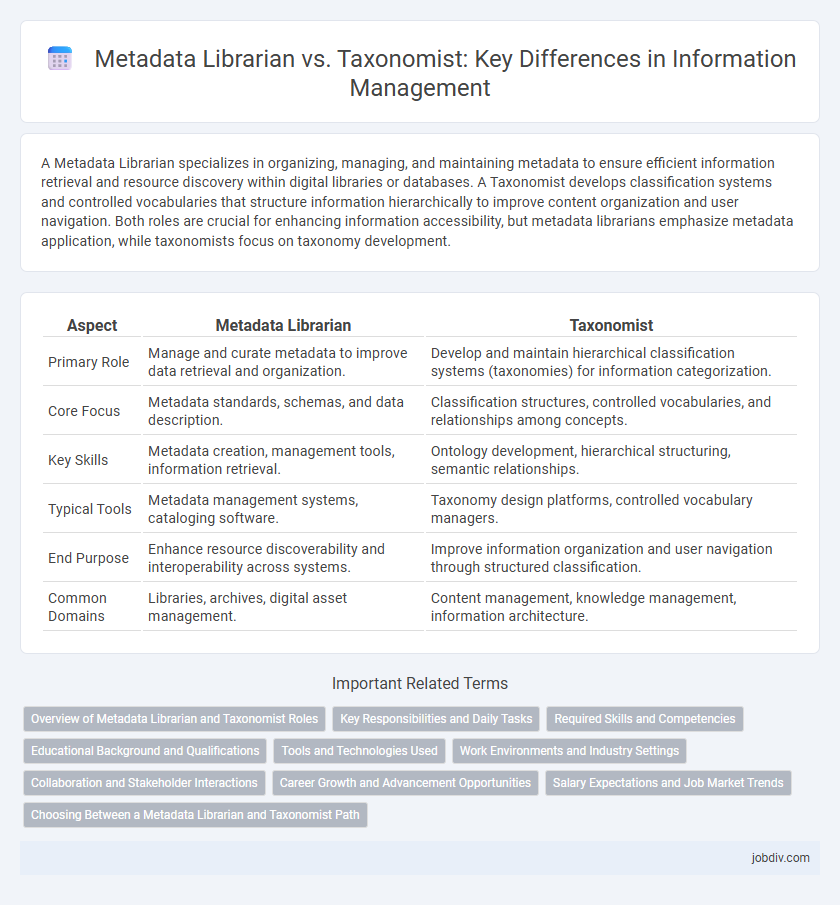A Metadata Librarian specializes in organizing, managing, and maintaining metadata to ensure efficient information retrieval and resource discovery within digital libraries or databases. A Taxonomist develops classification systems and controlled vocabularies that structure information hierarchically to improve content organization and user navigation. Both roles are crucial for enhancing information accessibility, but metadata librarians emphasize metadata application, while taxonomists focus on taxonomy development.
Table of Comparison
| Aspect | Metadata Librarian | Taxonomist |
|---|---|---|
| Primary Role | Manage and curate metadata to improve data retrieval and organization. | Develop and maintain hierarchical classification systems (taxonomies) for information categorization. |
| Core Focus | Metadata standards, schemas, and data description. | Classification structures, controlled vocabularies, and relationships among concepts. |
| Key Skills | Metadata creation, management tools, information retrieval. | Ontology development, hierarchical structuring, semantic relationships. |
| Typical Tools | Metadata management systems, cataloging software. | Taxonomy design platforms, controlled vocabulary managers. |
| End Purpose | Enhance resource discoverability and interoperability across systems. | Improve information organization and user navigation through structured classification. |
| Common Domains | Libraries, archives, digital asset management. | Content management, knowledge management, information architecture. |
Overview of Metadata Librarian and Taxonomist Roles
Metadata librarians specialize in organizing, managing, and preserving digital and physical information resources through metadata standards such as Dublin Core and MARC. Taxonomists develop classification schemes and controlled vocabularies to facilitate content discovery and information retrieval across various domains. Both roles collaborate to enhance data organization, but metadata librarians focus on cataloging and metadata creation, while taxonomists concentrate on structuring knowledge through hierarchical and relational taxonomies.
Key Responsibilities and Daily Tasks
Metadata librarians specialize in organizing and maintaining digital information through creating and managing metadata schemas, ensuring discoverability and accessibility of digital assets. Taxonomists focus on developing and implementing classification systems and controlled vocabularies to enhance information retrieval and user navigation across large data sets. Both roles require regular collaboration with content creators and IT teams to update and optimize data organization structures for efficient knowledge management.
Required Skills and Competencies
Metadata librarians require expertise in cataloging standards, metadata schemas such as Dublin Core and MARC, and proficiency with library management systems to ensure accurate data organization and retrieval. Taxonomists must possess strong analytical skills, experience with classification frameworks, and knowledge of controlled vocabularies to develop and maintain structured taxonomies that enhance content discoverability. Both roles demand attention to detail, familiarity with information architecture, and the ability to collaborate with content creators and IT professionals.
Educational Background and Qualifications
Metadata librarians usually hold a master's degree in library science (MLS or MLIS) with specialized training in cataloging, metadata standards, and digital asset management. Taxonomists often have a background in information science, linguistics, or computer science, emphasizing expertise in classification systems, ontology development, and information architecture. Both roles benefit from certifications in metadata standards like Dublin Core or taxonomic tools but differ in their educational focus, with metadata librarians leaning towards library science and taxonomists toward data organization and semantic structures.
Tools and Technologies Used
Metadata librarians commonly utilize integrated library systems (ILS) like Koha and metadata management tools such as MARCEdit and OpenRefine to organize and enhance digital collections. Taxonomists rely heavily on classification software like PoolParty and TopBraid Composer, which support taxonomy creation, ontology management, and semantic web technologies. Both professions increasingly adopt linked data tools and Python-based scripting for automation and improved data interoperability.
Work Environments and Industry Settings
Metadata librarians primarily work in academic libraries, archives, museums, and government agencies, focusing on organizing digital and physical collections for easy retrieval. Taxonomists are often employed in corporate settings, including large enterprises, e-commerce companies, and content management firms, where they develop classification systems and controlled vocabularies to enhance data discoverability. Both roles require collaboration with IT and knowledge management teams to ensure effective information architecture and resource accessibility.
Collaboration and Stakeholder Interactions
Metadata librarians and taxonomists collaborate closely to ensure accurate organization and classification of information systems, enhancing data retrieval and user experience. Metadata librarians focus on creating and maintaining descriptive information about digital resources, while taxonomists develop and manage controlled vocabularies and hierarchical structures. Effective collaboration with stakeholders, including content creators, IT teams, and end-users, ensures alignment of metadata standards and taxonomy with organizational goals.
Career Growth and Advancement Opportunities
Metadata librarians and taxonomists both offer distinct career growth opportunities within information management; metadata librarians typically advance through roles such as digital asset management or systems analyst, leveraging expertise in organizing and maintaining digital information. Taxonomists often progress by specializing in ontology development or information architecture, enhancing metadata standards and classification systems that improve data retrieval and usability. Both careers benefit from continuous learning in data science, AI integration, and evolving information technologies, which are critical for advancing in competitive, technology-driven environments.
Salary Expectations and Job Market Trends
Metadata librarians typically earn between $50,000 and $75,000 annually, with strong demand in academic and corporate libraries driven by increasing digital information management needs. Taxonomists command salaries ranging from $60,000 to $90,000, benefiting from growth in e-commerce and digital content industries requiring advanced classification expertise. Job market trends indicate stable growth for metadata librarians due to ongoing digital transformation, while taxonomists experience accelerated demand particularly in technology and knowledge management sectors.
Choosing Between a Metadata Librarian and Taxonomist Path
Choosing between a Metadata Librarian and a Taxonomist path depends on the focus of information management needed. Metadata Librarians specialize in organizing, cataloging, and maintaining digital and physical collections using standardized metadata schemas, enhancing discoverability and access. Taxonomists design and implement hierarchical classification systems, creating controlled vocabularies and ontologies that improve information retrieval and semantic interoperability across databases.
Metadata Librarian vs Taxonomist Infographic

 jobdiv.com
jobdiv.com